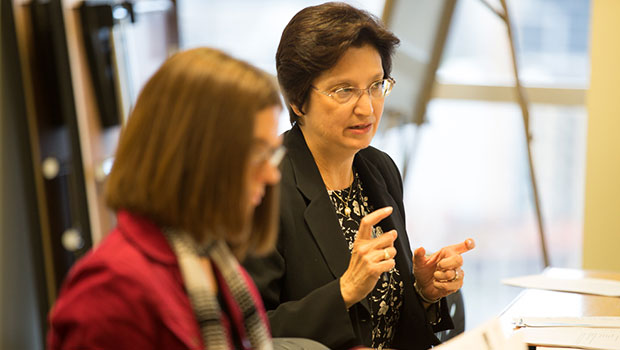Greatest hits: How Group Health research changed the world in 2013

Looking back at 2013, how did Group Health research influence care in the real world? Whether our results made an immediate splash or rippled out more gradually, our year-end review shows our work is improving health outcomes, practice, and policy—at Group Health and beyond.
“Our diverse lines of research are contributing to the transformation of health care overall, guided by concepts of preventive care and the Chronic Care Model,” said Michael Von Korff, ScD, a senior investigator at Group Health Research Institute (GHRI).
This makes Group Health research practical, which means much of it can quickly be put to good use. And we’re increasingly productive, now publishing nearly a paper a day in a variety of fields. So the following list is far from inclusive. But here are some of our “greatest hits” for 2013:
Delivering primary care better
By evaluating the patient-centered medical home as it evolves, we’re helping to build evidence to ensure that a team of providers can help give patients the care they need. Our recent evaluation linked the medical home’s system-wide spread throughout Group Health to fewer emergency visits and hospital stays
In 2013 the Institute’s MacColl Center for Health Care Innovation produced a tool for practices to use when assessing their progress toward transformation into a medical home. Working on the Safety Net Medical Home Initiative with The Commonwealth Fund and Qualis Health, the Center wrapped up helping to transform care in community health centers across the United States. And the LEAP (Learning from Effective Ambulatory Practices) project reported that many high-performing primary care practices are empowering non-physician team members to provide some care.
Within the context of the medical home, our research in areas including shared decision making and TEAMcare keeps making waves around the world, and our researchers recently implemented and tested these successful randomized controlled trials:
- Systems of Support (SOS) to improve colorectal cancer screening: In this trial, a centralized, automated approach doubled patients’ rates of on-time screening for cancer of the colon and rectum—and saved health costs—over two years. This project has influenced care at Group Health, and now through a grant from NIH’s Health Care Systems Research Collaboratory is being adapted to study in other settings, including community health centers.
- Nurse navigators for early cancer care: In this trial, when Group Health patients received support from a nurse navigator soon after a cancer diagnosis, they had better experiences and fewer problems with their care—particularly in health information, care coordination, and psychological and social care. Group Health was so impressed with this work that it has already incorporated an oncology nurse navigator into usual care for women newly diagnosed with breast cancer at its Capitol Hill campus.
Improving health outcomes
Our Pfizer-funded research supported the licensing of the first pneumococcal vaccine for use in adults since the polysaccharide vaccine was approved 30 years ago. We helped develop a model of meningococcal disease in Africa and used it to plan vaccination strategies in Burkina Faso; the World Health Organization has asked us to use it for other countries. And we’re helping protect the public from infectious diseases, including bird flu, as one of the lead sites in the nationwide network of Vaccine and Treatment Evaluation Units.
Linking higher blood sugar levels—even in people without diabetes—to dementia, our research implies that a strategy that aims to lower blood sugar levels would be a good way to reduce rates of late-life dementia. ABC News called this a top-15 diet and weight loss story of 2013.
We found that yoga may help insomnia in menopausal women, who have had few non-drug options for treating their symptoms. And we’ve developed practical tools to prevent suicide, including asking depressed patients about self-harm—to identify who needs sustained, organized follow-up care. This work has informed a new process for suicide risk assessment at Group Health and elsewhere.
Curbing harms of health care
Several recent strands of Group Health research have had major impacts in efforts to curb potential harms, and maximize benefits, from health care. For instance, Group Health research on the safety of CT scans—including in children—spurred efforts to improve CT scan safety at Group Health and other systems. This is among the top-10 radiology stories of 2013, according to Aunt Minnie, a publication for radiologists.
Through the Breast Cancer Surveillance Consortium (BCSC), we have shown some overuse (and underuse) of breast MRI for screening. And we have found that mammograms may be best, with fewer false-positives, every other year, instead of yearly, for screening women of average risk at ages 50–74 and older.
Our research showed that children react less when DTaP vaccine is given in their thighs than in their arms. And our work on opioid prescribing continues to spread, serving as a model for many other health systems and helping to inform the federal government’s plan to curb a nationwide epidemic of narcotic prescription drug overuse and abuse. Another harm of care is its financial cost—and we are exploring that, too.
Going forward
The Affordable Care Act (ACA) requires that nonprofit hospitals conduct a needs assessment every three years. In 2013 the Institute’s Center for Community Health and Evaluation (CCHE) conducted a community needs assessment for Group Health, which has informed the implementation strategy for Group Health’s community involvement. And as the ACA continues to be implemented, our research—including studying accountable care organizations (ACOs)—will continue to be pivotal.
“As we focus on our next 30 years, we should ask: What level of impact should we strive for?” said Jennifer McClure, PhD, GHRI director of research, faculty, and development and a senior investigator. “And how can we, as investigators and leaders in Group Health research, make that happen?”


